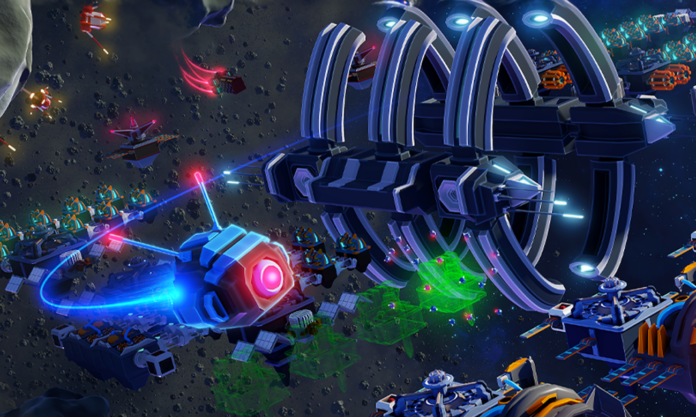He got the idea after playing Factorio for hundreds of hours, but in the six years of development that followed, Ben Ryding came up with a delightful twist on the genre. Final Factory blends factory building and spaceship design with RTS-style troop commanding and classic bullet-hell gameplay. Pretty impressive for a largely solo-developed game.
“At this stage the game is more like a cross between Factorio and Cosmoteer”, explains Ryding. “One of the biggest things that sets it apart, aside from the space station design, is the ability to design mobile stations, mobile factories, battleships, and cargo haulers, by slapping rockets onto any of your creations. No other automation game does anything like this as far as I’m aware.”
“I’m a huge hard-sci-fi nerd and have been inspired by many books like the Bobiverse, Dragon’s Egg, Three Body Problem, and many others. Hence the premise of the game is that you are a Von Neumann probe, sent to consume all the resources in the Universe and build the ultimate, final, factory. There’s lots of little sci-fi easter eggs and ideas in the game.”
Jack of all Trades
Ryding has been working on games in his spare time for nearly 15 years, before officially forming the studio Never Games in 2019. He was working alone on Final Factory, which was called Astero at the time, in his home. Things were getting serious three years later when Ryding decided to quit his job as a software engineer and work full time as a game developer. “One of my close friends, Ches Denison, joined me working 5-10 hours a week as a playtester, game designer, and just a general jack-of-all-trades-guy. In early 2023, another friend of mine and former coworker, Kyle Tinker, also known as Lothsahn, joined as a part-time developer as well. Loth is one of the best engineers I’ve worked with, and has helped a ton with performance and code quality.”

After working on the game by himself for so long, Ryding actually enjoyed the support of his additional team mates. “Ches lives about 10 minutes away from me in Boulder, Colorado, so we’d frequently work in the same house”, he says. “Loth works remote out of Kansas. But all of us being more or less remote was not really an obstacle to sharing work. The primary obstacle is just getting people up to speed on the code base and development practices. Final Factory is a very complex game and it takes a developer awhile to start finding their way around the code, just like any job.”
Interlocking systems
Before having a team, Ryding calls his creative process ‘mostly inspiration-driven’. “Ideas would strike me and I’d feel compelled to implement them right away”, he says. “As the game grew, the bigger picture became clearer, making it easier to decide what to include or cut. Once playtesting began in early 2023, player feedback further refined my vision. Design is never truly finished, so my teammates and I constantly discuss game design and how to incorporate player feedback. I plan to support and expand the game for years to come.”

“I’m most proud of the game’s extensive content and numerous interlocking systems”, Ryding continues. “Players can easily sink hundreds of hours into the game, discovering countless ways to build and strategize. I’m also particularly proud of the unique mobile stations feature. I wanted the game to be about creating and designing modular space stations, and iterated on that for a long time before landing on the heat/power/stability gameplay that drives the experience.”
Sleepless nights
The factories that you can ultimately build are a sight to behold. Structures so large that they can only exist in the vastness of space, with countless moving parts all firing in perfect synchronization, fill up the screen. “Constraints often lead to great artistic results”, says Ryding smiling. “The visual style was largely determined by my limitations as a 3D artist. I aimed for a simple yet visually interesting aesthetic, using a 4-color palette for each unit or building and keeping polygon counts low for simplicity and performance. This lean asset pipeline allows me to quickly create and iterate on new art and models, which is crucial for small dev teams.”
When asked about the most challenging aspect of the project, Ryding names the stress and uncertainty surrounding game development. “Quitting a stable software job to pursue this dream, facing fierce competition, and worrying about post-launch success and financial stability have led to many sleepless nights and anxiety. Community management is also a significant challenge. Despite the difficulties, my passion for making games keeps me going.”
“Plus, maintaining a healthy work-life balance is the most important thing you can do as a game dev. I had a long adjustment period after quitting my full time job where I was grinding out 80-90 hour weeks working on Final Factory, and stressing a ton about the community I had formed around the game. It caused a lot of strife in my personal life. These days I’ve learned to work a little less and give myself breaks. Although I’m still not perfect at this!”
Final Factory is out on Steam Early Access. Get the game here.

